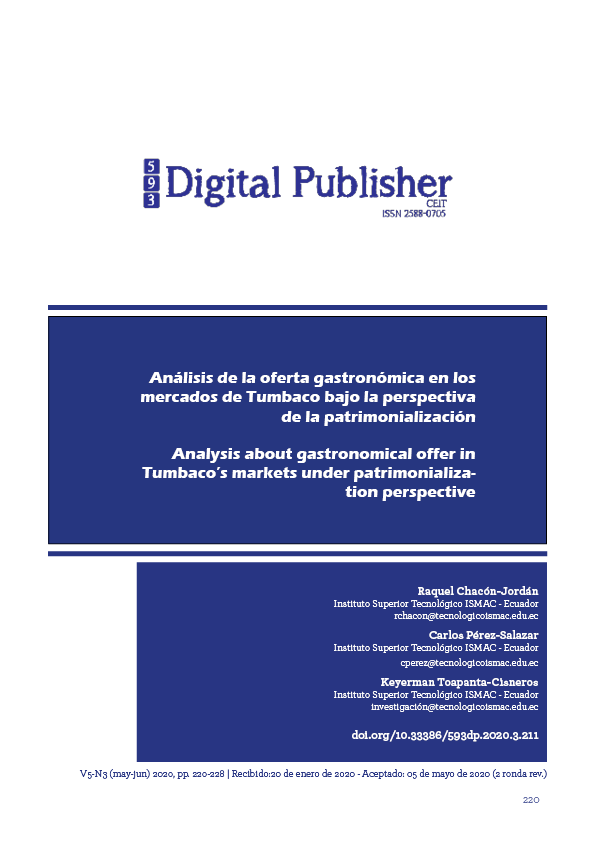Analysis about gastronomical offer in Tumbaco’s markets under patrimonialization perspective
Main Article Content
Abstract
The present research work analyses the influential factors in the processes of gastronomic heritage and as a main problem was evidenced that is necessary to make an analysis of, as well as its actors and elements to know its intervention in the strengthening of cultural identity; taking feeding from a perspective inclined to anthropology, to be able to gather information about the importance and value of the rescue and presence of daily eating habits in vernacular places such as markets. For this, a descriptive non-experimental research design has been used, using primary data collection methods, and using the survey as a useful tool to collect specific opinions in the study area, with a sample of three hundred eighty three (383) people; obtaining in this way that, the gastronomic offer in the markets is a heritage asset in the culture of Tumbaco’s parish, when it is sorted out in a tradition that remains in force after having passed from generation to generation, which is worth rescuing and keep, has granted a sense of identity to the social group that needs to be reaffirmed in it; in order to find itself in the advantageous situation of social revitalization and appropriation of cultural baggage. Currently, based on the results obtained, it was found that, through the study, enhancement and promotion of cultural values that are generated around the food supply in the market, it is possible to generate a strengthening of the cultural identity of the citizens in Tumbaco.
Downloads
Article Details
1. Derechos de autor
Las obras que se publican en 593 Digital Publisher CEIT están sujetas a los siguientes términos:
1.1. 593 Digital Publisher CEIT, conserva los derechos patrimoniales (copyright) de las obras publicadas, favorece y permite la reutilización de las mismas bajo la licencia Licencia Creative Commons 4.0 de Reconocimiento-NoComercial-CompartirIgual 4.0, por lo cual se pueden copiar, usar, difundir, transmitir y exponer públicamente, siempre que:
1.1.a. Se cite la autoría y fuente original de su publicación (revista, editorial, URL).
1.1.b. No se usen para fines comerciales u onerosos.
1.1.c. Se mencione la existencia y especificaciones de esta licencia de uso.
References
Albert, M. F. (2014). La patrimonialización de la cultura alimentaria: apuntes para su desarrollo en el caso de la miel de Ayora. En U. d. Valencia, Educación y entorno territorial de la Universitat de Valencia (págs. 117-127). España.
Altamirano, N. B. (Noviembre de 2017). La patrimonialización como un recurso para la preservación de la fiesta andina. Caso la Yumbada de Cotocollao. Quito.
Andrango, J. (2016). Gastronomía de la provincia de Imbabura como patrimonio cultural inmaterial del ecuador parroquia Imbaya cantón Antonio Ante. Ibarra.
Comisión para la preservación del patrimonio histórico cultural de la Ciudad de Buenos Aires. (2005). La cocina como patrimonio intangible. Buenos Aires.
Del Río, L. I. & Román, J. F. (2017). El patrimonio gastronómico de México y sus regiones. Revista Ph Perspectivas.Andalucía.
GAD de Tumbaco. (15 de 01 de 2015). Plan de Desarrollo y Ordenamiento Territorial de Tumbaco. Quito, Ecuador.
Hernández, S. R. “Metodología de la Investigación”. Sexta edición ed. Mexico. 2014. McGrawHill
Hernández-Ramírez , J. (2018). Cuando la alimentación se convierte en gastronomía. Procesos de activación patrimonial de tradiciones alimentarias. CUHSO, 154-176.
Matta, R. (Enero de 2015). ResearchGate. Obtenido de https://www.researchgate.net/publication/298401905_Conocimiento_y_poder_practicas_alimentarias_y_patrimonializacion_cultural
Medina, X. (2017). Reflexiones sobre el patrimonio y la alimentación desde las perspectivas cultural y turística. Anales de Antropología, 106-113.
Ministerio de Turismo. “Ecuador Culinario: saberes y sabores”. (en línea), 2013, consultado por internet el 5 de Junio de 2017. Dirección de Internet. http://www.turismo.gob.ec/ecuador-culinario-saberes-y-sabores/
Municipio del Distrito Metropolitano de Quito. (2019). Quito. Obtenido de http://www.quito.gob.ec/index.php/administracion-zonales/administracion-zonal-tumbaco#%C3%A1rea-de-intervenci%C3%B3n
Osorio, R., Serrano, R. & Palmas. (2018). Patrimonialización y patrimonio inmaterial, como elemento dinamizador de la economía local en Zacazonapan Estado de México. México: International Journal of Scientific Management and Tourism.
Piña, P. A. (2013). Cultura y alimentación. Aspectos fundamentales para una visión comprensiva de la alimentación humana. México.
UNESCO. (2003). Convención para la salvaguardia del patrimonio cultural inmaterial. París.
Unigarro, C. (2015). Sistemas alimentarios y patrimonio alimentario. Transculturaciones en el caso ecuatoriano. Quito: Antropología Cuadernos de Investigación

